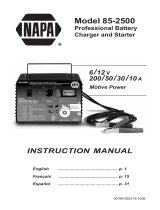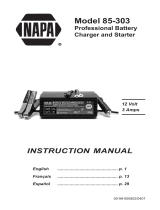Page is loading ...

Model CBC-1000
Manual Battery Charger
OWNER’S MANUAL
00-99-000889/0708
Voltage: 12
Amperage: 1
READ ENTIRE MANUAL BEFORE
USING THIS PRODUCT


• 1 •
IMPORTANT SAFETY INSTRUCTIONS1.
SAVE THESE INSTRUCTIONS – This manual contains important safety 1.1
and operating instructions for battery charger Model CBC-1000.
Do not expose charger to rain or snow.1.2
Use of an attachment not recommended or sold by the battery charger 1.3
manufacturer may result in a risk of re, electric shock, or injury to per-
sons.
To reduce risk of damage to electric plug and cord, pull by plug rather than 1.4
cord when disconnecting charger.
An extension cord should not be used unless absolutely necessary. Use of 1.5
improper extension cord could result in a risk of re and electric shock. If
an extension cord must be used, make sure:
That pins on plug of extension cord are the same number, size, and •
shape as those of plug on charger;
That extension cord is properly wired and in good electrical condition and;•
That wire size is large enough for AC ampere rating of charger as speci-•
ed in Table 8.2.
Do not operate charger with damaged cord or plug; take to a qualied 1.6
service person. (Call customer service at: 888-263-4906.)
Do not operate charger if it has received a sharp blow, been dropped, or 1.7
otherwise damaged in any way; take it to a qualied serviceman. (Call
customer service at: 888-263-4906.)
Do not disassemble charger; take it to a qualied serviceman when 1.8
service or repair is required. Incorrect reassembly may result in a risk of
electric shock or re. (Call customer service at: 888-263-4906.)
To reduce risk of electric shock, unplug charger from outlet before attempt-1.9
ing any maintenance or cleaning. Turning off controls will not reduce this
risk.
WARNING – RISK OF EXPLOSIVE GASES.
WORKING IN VICINITY OF A LEAD-ACID BATTERY IS DANGEROUS.
BATTERIES GENERATE EXPLOSIVE GASES DURING NORMAL
BATTERY OPERATION. FOR THIS REASON, IT IS OF UTMOST
IMPORTANCE THAT YOU FOLLOW THE INSTRUCTIONS EACH TIME
YOU USE THE CHARGER.
TO REDUCE RISK OF BATTERY EXPLOSION, FOLLOW THESE
INSTRUCTIONS AND THOSE PUBLISHED BY BATTERY MANUFAC-
TURER AND MANUFACTURER OF ANY EqUIPMENT YOU INTEND TO
USE IN VICINITY OF BATTERY. REVIEW CAUTIONARY MARKING ON
THESE PRODUCTS AND ON ENGINE.
IMPORTANT: READ AND SAVE THIS SAFETY AND INSTRUCTION MANUAL.

• 2 •
PERSONAL PRECAUTIONS2.
Consider having someone close enough by to come to your aid when you 2.1
work near a lead-acid battery.
Have plenty of fresh water and soap nearby in case battery acid contacts 2.2
skin, clothing, or eyes.
Wear complete eye protection and clothing protection. Avoid touching 2.3
eyes while working near battery.
If battery acid contacts skin or clothing, wash immediately with soap and 2.4
water. If acid enters eye, immediately ood eye with running cold water for
at least 10 minutes and get medical attention immediately.
NEVER smoke or allow a spark or ame in vicinity of battery or engine.2.5
Be extra cautious to reduce risk of dropping a metal tool onto battery. It 2.6
might spark or short-circuit battery or other electrical part that may cause
explosion.
Remove personal metal items such as rings, bracelets, necklaces, and 2.7
watches when working with a lead-acid battery. A lead-acid battery can
produce a short-circuit current high enough to weld a ring or the like to
metal, causing a severe burn.
Use charger for charging a LEAD-ACID battery only. It is not intended to 2.8
supply power to a low voltage electrical system other than in a starter-mo-
tor application. Do not use battery charger for charging dry-cell batteries
that are commonly used with home appliances. These batteries may burst
and cause injury to persons and damage to property.
NEVER charge a frozen battery.2.9
PREPARING TO CHARGE3.
If necessary to remove battery from vehicle to charge, always remove 3.1
grounded terminal from battery rst. Make sure all accessories in the
vehicle are off, so as not to cause an arc.
Be sure area around battery is well ventilated while battery is being 3.2
charged.
Clean battery terminals. Be careful to keep corrosion from coming in con-3.3
tact with eyes.
Add distilled water in each cell until battery acid reaches level specied by 3.4
battery manufacturer. Do not overll. For a battery without removable cell
caps, such as valve regulated lead acid batteries, carefully follow manu-
facturer’s recharging instructions.
Study all battery manufacturer’s specic precautions while charging and 3.5
recommended rates of charge.
Determine voltage of battery by referring to vehicle owner’s manual and 3.6
make sure that output voltage selector switch is set at correct voltage. If
charger has adjustable charge rate, charge battery initially at lowest rate.

• 3 •
CHARGER LOCATION4.
Locate charger as far away from battery as DC cables permit.4.1
Never place charger directly above battery being charged; gases from bat-4.2
tery will corrode and damage charger.
Never allow battery acid to drip on charger when reading electrolyte spe-4.3
cic gravity or lling battery.
Do not operate charger in a closed-in area or restrict ventilation in any 4.4
way.
Do not set a battery on top of charger.4.5
DC CONNECTION PRECAUTIONS5.
Connect and disconnect DC output clips only after setting any charger 5.1
switches to “off” position and removing AC cord from electric outlet. Never
allow clips to touch each other.
Attach clips to battery and chassis, as indicated in 6.5, 6.6, and 7.2 5.2
through 7.4.
FOLLOW THESE STEPS WHEN BATTERY IS INSTALLED IN 6.
VEHICLE.
A SPARK NEAR BATTERY MAY CAUSE BATTERY EXPLOSION. TO
REDUCE RISK OF A SPARK NEAR BATTERY:
Position AC and DC cords to reduce risk of damage by hood, door, or 6.1
moving engine part.
Stay clear of fan blades, belts, pulleys, and other parts that can cause 6.2
injury to persons.
Check polarity of battery posts. POSITIVE (POS, P, +) battery post usually 6.3
has larger diameter than NEGATIVE (NEG, N,–) post.
Determine which post of battery is grounded (connected) to the chassis. 6.4
If negative post is grounded to chassis (as in most vehicles), see (6.5). If
positive post is grounded to the chassis, see (6.6).
For negative-grounded vehicle, connect POSITIVE (RED) clip from battery 6.5
charger to POSITIVE (POS, P, +) ungrounded post of battery. Connect
NEGATIVE (BLACK) clip to vehicle chassis or engine block away from
battery. Do not connect clip to carburetor, fuel lines, or sheet-metal body
parts. Connect to a heavy gauge metal part of the frame or engine block.
For positive-grounded vehicle, connect NEGATIVE (BLACK) clip from bat-6.6
tery charger to NEGATIVE (NEG, N, –) ungrounded post of battery. Con-
nect POSITIVE (RED) clip to vehicle chassis or engine block away from
battery. Do not connect clip to carburetor, fuel lines, or sheet-metal body
parts. Connect to a heavy gauge metal part of the frame or engine block.

• 4 •
When disconnecting charger, turn switches to off, disconnect AC cord, 6.7
remove clip from vehicle chassis, and then remove clip from battery termi-
nal.
See OPERATING INSTRUCTIONS for length of charge information.6.8
FOLLOW THESE STEPS WHEN BATTERY IS OUTSIDE VEHICLE. 7.
A SPARK NEAR THE BATTERY MAY CAUSE BATTERY EXPLOSION.
TO REDUCE RISK OF A SPARK NEAR BATTERY:
Check polarity of battery posts. POSITIVE (POS, P, +) battery post usually 7.1
has a larger diameter than NEGATIVE (NEG, N, –) post.
Attach at least a 24-inch-long 6-gauge (AWG) insulated battery cable to 7.2
NEGATIVE (NEG, N, –) battery post.
Connect POSITIVE (RED) charger clip to POSITIVE (POS, P, +) post of 7.3
battery.
Position yourself and free end of cable as far away from battery as pos-7.4
sible – then connect NEGATIVE (BLACK) charger clip to free end of cable.
Do not face battery when making nal connection.7.5
When disconnecting charger, always do so in reverse sequence of con-7.6
necting procedure and break rst connection while as far away from bat-
tery as practical.
A marine (boat) battery must be removed and charged on shore. To 7.7
charge it onboard requires equipment specially designed for marine use.

• 5 •
BATTERY CHARGING - AC CONNECTIONS8.
For grounded, cord-connected battery chargers with an input rating 8.1
less than 15 amperes and intended for use on a nominal 120-volt
circuit:
This battery charger is for use on a nominal 120-volt circuit, and has a •
grounding plug that looks like the plug illustrated in sketch A in Figure
8.3. A temporary adapter, which looks like the adapter illustrated in
sketches B and C, may be used to connect this plug to a two-pole recep-
tacle as shown in sketch B if a properly grounded outlet is not available.
The temporary adapter should be used only until a properly grounded
outlet can be installed by a qualied electrician.
DANGER – Before using adapter as illustrated, be certain that center
screw of outlet plate is grounded. The green-colored rigid ear or lug ex
tending from adapter must be connected to a properly grounded outlet–
make certain it is grounded. If necessary, replace original outlet cover
plate screw with a longer screw that will secure adapter ear or lug to out-
let cover plate and make ground connection to grounded outlet.Recom-
mended minimum awg size for extension cords for battery chargers:
8.2
AWG Size of Cord 25 50 100 150
Length of Cord, Feet 18 18 18 16
8.3
Grounding Methods

• 6 •
ASSEMBLY INSTRUCTIONS9.
No assembly required•
OPERATING INSTRUCTIONS10.
This unit is a manual charger and care must be taken to prevent over-10.1
charging. Manual chargers will not shut off by themselves. While charging,
manual chargers must not be left unattended as severe battery damage
or other hazardous conditions may result. We recommend monitoring the
battery’s condition at 1 to 2 hour intervals until full charge is reached.
Follow all safety and operating instructions in this manual.10.2
Before connecting charger clips, make sure charger is removed from 10.3
electrical outlet.
When battery is installed in vehicle or equipment, follow connection 10.4
sequence in section 6. When battery is charged outside vehicle or equip-
ment, follow sequence in section 7.
Insert charger into electrical outlet.10.5
After charging is complete, disconnect charger, remove clip from vehicle 10.6
chassis and then remove clip from battery terminal. When charging battery
outside of vehicle or equipment, follow procedures covered in section 7.
MAINTENANCE INSTRUCTIONS11.
Before performing maintenance, unplug and disconnect battery charger 11.1
(see sections 6.7 and 7.6).
After use, use a dry cloth to wipe all battery corrosion and other dirt or oil 11.2
from terminals, cords, and the charger case.
Servicing does not require opening unit, as there are no user-serviceable 11.3
parts.
STORAGE INSTRUCTIONS12.
Store charger unplugged, in an upright condition. Cord will still conduct 12.1
electricity until it is unplugged from outlet.
Store inside, in a dry, cool place.12.2
Do not store clips on handle, clipped together, on or around metal, or 12.3
clipped to cables.
BEFORE RETURNING FOR REPAIR13.
When a charging problem arises, make certain battery is capable of ac-13.1
cepting a normal charge. Use a good battery to double-check all connec-
tions, AC outlet for full 120 volts, charger clips for correct polarity, and the
quality of connections from cable to clips and clips to battery system. Clips
must be clean.

• 7 •
When a battery is very cold, partially charged, or sulfated, it will not draw
full rated amperes from charger. It is both dangerous and damaging to
a battery to force a higher amperage into it than it can effectively use in
recharging.
When an UNKNOWN OPERATING PROBLEM arises, please reread com-13.2
plete manual and call the customer service number for information that will
usually eliminate need for return.
When charger requires repair of KNOWN DAMAGE, please call customer 13.3
service number for nearest service station address or instructions for fac-
tory return.
Call Customer Service at: 888-263-4906 Monday - Friday, 7 a.m. to 5 p.m.

• 8 •
/




